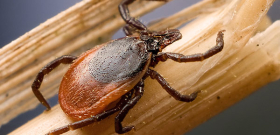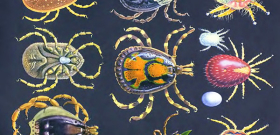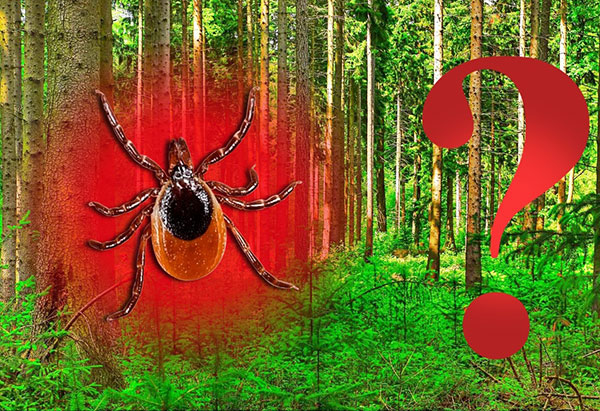
The world of ticks is very diverse: today more than 54 thousand species of these arachnids are known. The greatest threat among them to humans is ixodid ticks (Ixodidae), which feed on blood. Representatives of this family live everywhere due to their ability to survive in sometimes extreme conditions.
Despite this, it is widely believed that there are places that ticks inexplicably avoid. In particular, many argue that ticks are not found in a pine forest, although statistics on cases of attacks by these bloodsuckers show the opposite. These parasites live both in mixed and deciduous and coniferous forests and successfully feed on animals and sometimes on humans there. For a tick, it is not so much the type of forest that is important, but favorable climatic conditions and the presence of a sufficient number of hosts nearby.
Among the huge number of different types of ixodid that live on the territory of the Russian Federation, the most interesting for a simple layman are taiga tick (Ixodes persulcatus) and dog tick (Ixodes ricinus). They most often attack humans and are carriers of dangerous diseases. It is these two types that we will consider in more detail ...
It's important to know
Tick saliva can contain viruses, bacteria, and protozoa that cause serious illnesses such as tick-borne borreliosis (Lyme disease), tick-borne encephalitis, typhus, hemorrhagic fever and many others.
Where does the taiga tick live?
As the name implies, the taiga tick mainly lives in the taiga, which is characterized by the predominance of coniferous plants. Considering that the area of boreal forests occupies most of Russia, this parasite can be found in almost any corner of our country: from the Kuril Islands in the east to the Leningrad region in the west.
The area of distribution of the taiga tick stretches across the entire southern part of the Siberian taiga, in the west it captures the Moscow and Leningrad regions, then the Baltic countries, in the south of Russia it is found on the territory of the entire Altai.

The taiga tick, which belongs to the Ixodes family, is distributed throughout almost all of Russia.
In addition to coniferous forests, the taiga tick is found in both mixed and broad-leaved forests, and is found in the forest-steppe. It avoids swampy areas, young clearings and open meadows, as well as dry sparse pine forests, where sandy soil prevails and grass is practically absent, which is the tick's favorite place to lie in wait for the victim. The taiga tick can also lie in wait for its victims on low bushes, but the parasite does not climb trees.
Thus, the type of forest does not particularly affect the presence or absence of ticks in it, but a favorable microclimate and sufficient food supply play an important role. And whether it is a pine forest, spruce or deciduous, ticks can be found everywhere if the conditions are suitable for them.
But in which part of the forest the chance of an unpleasant meeting is higher is another question. The number of bloodsuckers is distributed in the forest rather unevenly.Tick larvae live in aggregates, that is, they form clusters in some areas. This is due to the fact that they are not able to spread far. after hatching from eggs (this distance is only about 1.5 meters). Parasitizing on small rodents, the larvae do not spread over long distances.
There are also permanent areas with a high density of adults - these places are associated with favorable conditions for the development of nymphs and a large concentration of host animals, for example, trails to a watering place and pastures.

Ticks live in high density along trails trodden by animals.
However, you should not count on absolutely safe places in the forest, because ticks can be carried by their owners over long distances and eventually end up almost anywhere. Particularly rapid settlement of new territories by bloodsuckers occurs with the help of birds.
From the foregoing, it is obvious that visiting a pine forest does not eliminate the danger of meeting with a forest parasite, and the information that coniferous smell repels ticks is just a myth.
On a note
Taiga ticks are often carriers of the tick-borne encephalitis virus. This is a very dangerous disease that affects the nervous system. To date, there is no effective cure - only maintenance therapy. In most cases, without timely medical care, a sick person remains disabled, and in the worst case, dies.
Changes in the natural landscape do not lead to the disappearance of the taiga tick. After strong fires, parasite populations recover after a few years, they also adapt well to cities and are often found in gardens and parks.
The photo below shows what an adult female taiga tick looks like:
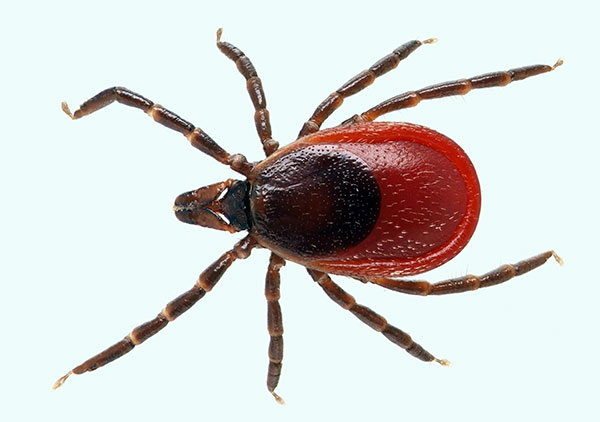
The structure of the taiga tick is typical for all types of ixodid. The parasite, like all arachnids, consists of two sections - head and body - and has four pairs of walking legs. The head is called a gnathosoma, it contains the oral apparatus, consisting of pedipalps, chelicerae and a proboscis covered with spikes, there are no eyes.
The body of the tick resembles a bag and is called an idiosome. The cuticle covering the idiosoma is elastic and able to stretch, thanks to which the blood-fed parasite increases several times.
dog tick
The dog tick is the most common type of ixodid, and, despite the name, is dangerous not only for dogs. Like the taiga, it attacks a person and is a carrier of dangerous diseases. Its other name is the European forest mite.
This parasite is found on all continents except Antarctica. Its range covers North Africa, Europe and Asia. Its greatest number is in broad-leaved forests, but also often the tick can be found in mixed forests, pastures and clearings.
The photo shows a dog tick:

Outwardly different types ixodid ticks very similar, only a specialist can distinguish between them. For example, the difference between the dog tick and the taiga tick is the presence of spines and membranous appendages on the inside of the leg segment.
Determining the type of tick by the natural zone in which it was found is also difficult, because the ranges of different species of these parasites intersect. Do not exclude the possibility of picking up a dog tick in a coniferous forest.
An interesting feature of these bloodsuckers is that the color of their color can change, it depends on the habitat and the degree of satiety, so determining the species on this basis, again, is difficult. As a result, there is nothing surprising in the fact that a seemingly taiga tick caught in a pine forest, in fact, turns out to be a European forest tick.
On a note
The dog tick is the main carrier of the bacteria that causes Lyme disease, or tick-borne borreliosis. This disease affects the nervous system, musculoskeletal system, cardiovascular system and internal organs. With a timely visit to a doctor, borreliosis is easily cured with a course of antibiotics, but in an advanced case it can lead to death. The main symptom of Lyme disease is an enlarged red ring around the bite sites. This phenomenon is called erythema migrans annulus.
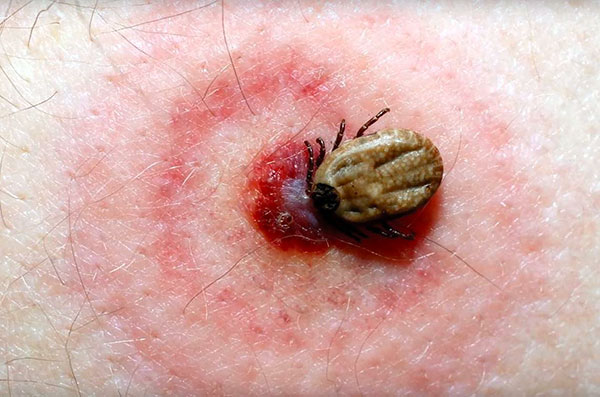
An annular erythema can be seen around the site of the Borreliosis tick bite.
It becomes obvious that the species of ticks described above have quite successfully adapted to life among various plants of Eurasia and, having great endurance to environmental influences, can safely live in different natural zones.
Influence of seasons on tick activity
Understanding that you can meet ticks anywhere, it is important to know at what time of the year this encounter is most likely.
In general, the risk of attack by blood-sucking parasites in Russia persists from early spring to late autumn. However, there are seasons of their special activity. This is spring-early summer, when ticks are especially hungry and crawl out in search of food after hibernation, and late summer-early autumn, when the heat peak subsides, and the humidity is still sufficient, and you can again wait for victims.
In addition, there are periods of the so-called diapause, when the activity of ticks is reduced and they are not dangerous to humans. One of them is called morphogenetic. It is manifested by a delay in the development of laid eggs, an increase in the period of preparation for molting in well-fed larvae and nymphs, and a slowdown in the development of germ cells in females. This process helps to synchronize life cycle arachnid with changes in seasons.
Another type of diapause is called behavioral. During this period, adults lack aggressiveness, that is, they stop looking for prey and attacking. This occurs during hibernation and during the hot summer period.

Tick activity subsides during the summer heat.
If we talk about the taiga with its light coniferous and larch forests, which stretches through the central and northern regions of Russia, then the activity of ticks here will not be the same. In central Russia, the activity of ticks (adults) will develop approximately as follows:
- Late spring-early summer - high activity after wintering;
- Mid-summer - a decline in activity associated with an unfavorable regime for ticks of high temperatures and low humidity;
- Late summer-early autumn - high activity before hibernation.
In northern latitudes, tick activity will be somewhat different:
- Early summer - high activity after wintering;
- Mid-summer - activity remains at a high level, or a short behavioral diapause is possible (depending on weather conditions);
- Late summer – activity may remain high before hibernation (in more northerly regions, ticks may already be in suspended animation).
Thus, in the northern regions, tick activity can remain at a high level throughout the summer period, while in the central regions there are two peaks of high activity interrupted by diapause.
Distribution of ticks in Russia
Every year, the Federal Service for Supervision of Consumer Rights Protection and Human Welfare (Rospotrebnadzor) informs about the beginning of the season of tick activity and registers cases of diseases. Every year, lists of endemic areas and regions are compiled.
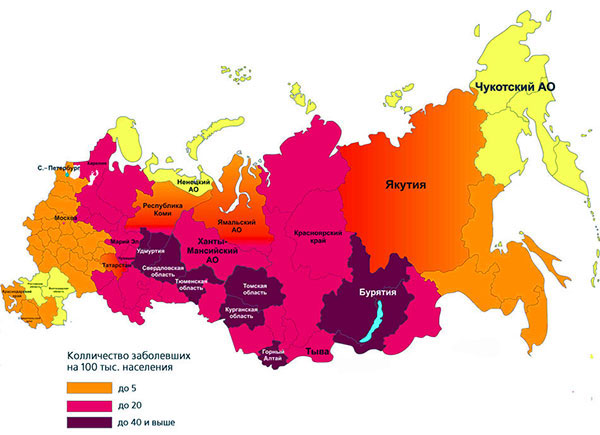
Map of the incidence of tick-borne encephalitis in the Russian Federation.
The leading place in infection with tick-borne encephalitis is occupied by Buryatia, Altai, Perm Territory, Tomsk, Sverdlovsk, Tyumen and Novosibirsk regions. The least attacks of infected ticks are recorded in Murmansk, the Nenets Autonomous Okrug, the Kamchatka Territory and the North Caucasus. This indicates that ticks are more active under favorable conditions, while regions with hotter or, conversely, too cold climates reduce the level of parasite activity.
In order to reduce the number of cases, as well as the safety of urban space, in our time in various regions of Russia, area tick treatment city parks, squares, kindergartens. However, there is no mass processing of forests, as it was in Soviet times. This is due, first of all, to economic unprofitability, since, firstly, the areas for processing are huge, and secondly, the procedure must be repeated several times per season. effect from modern acaricides, which would meet the conditions of safety, lasts only a few weeks.
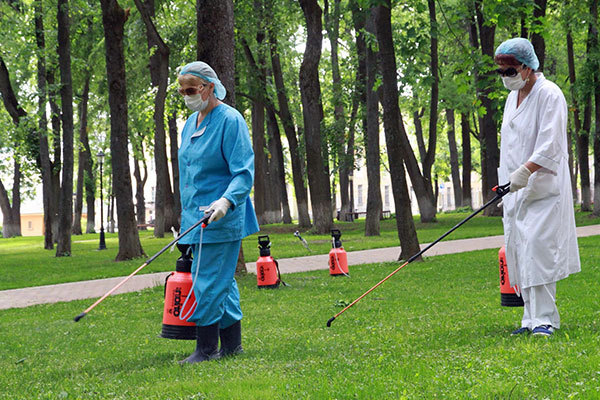
Anti-tick treatment of squares, parks, forest belts from ticks suggests a well-pronounced effect for only a few weeks.
In the USSR, after deaths from tick-borne encephalitis, chemical treatments began to be carried out in endemic areas. In addition to the mandatory processing of pioneer camps, sanatoriums, city parks, forests were also processed. This was done in early spring, before the snow melted, with the help of aviation. To combat the parasite, dichlorodiphenyltrichloroethane (DDT) was used, after which the bloodsuckers disappeared for a period of 2 to 5 years.
In the late 1980s, it turned out that DDT causes great harm to the environment and can accumulate not only in water and soil, but also in animals and humans, so the mass fight against ticks in this way was stopped. Modern means used against ticks are less dangerous, but their effect lasts for a shorter period.
Where do ticks hide and how do they attack?
Depending on the species and stage of development, parasites lie in wait for their victims on the ground, grass and shrubs at a height of several centimeters to a meter. The larvae live on the ground, in deciduous and coniferous litter, crawl into animal burrows and parasitize small rodents and birds. Nymphs sit on the grass and cling to larger warm-blooded ones, and they can also attack people. Adult individuals lie in wait for their victims on the grass and bushes, attack mammals and humans.
When a tick chooses a place to hunt, it is guided by the following parameters: temperature, humidity, availability of prey. Most often, these parasites are located on the grass along the animal trails, on the edges and clearings, pastures and vegetable gardens, in city parks and squares. Ticks do not climb trees, so there is no need to be afraid that a bloodsucker may fall or jump on his head from a birch or pine.
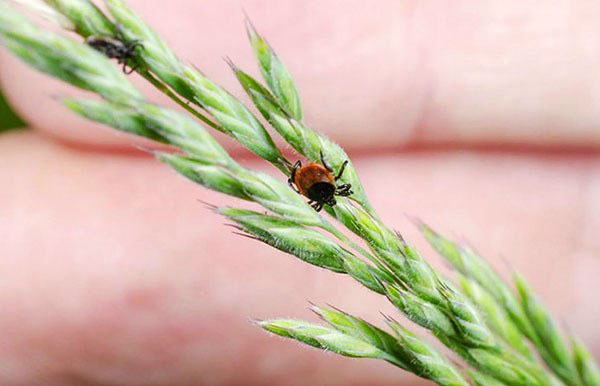
Ticks do not climb high. Their habitat is grass and small bushes.
On a note
There are mites that live on trees, such as spruce (Oligonychus ununguis) and pine (Oligonychus milleri) spider mites. They are completely harmless to humans and are plant parasites. In addition to spruces and pines, they also infect various conifers, arborvitae and junipers. The web, with which these parasites braid the shoots of plants, serves as a defense of the colony and, picked up by the wind, helps to disperse the pest. To combat spider mites, summer residents spray trees with special acaricidal compounds.
Having found a convenient place, the parasite freezes, extending the front pair of legs with claws. When the smell of prey reaches it, it turns in its direction and makes oscillatory movements with its front pair of legs until contact occurs.
It is interesting
Haller's organs are the main olfactory receptors of ticks. With their help, the parasite feels the victim by thermal radiation, smell and carbon dioxide released.
If the owner continues to be felt nearby, but contact has not occurred, the bloodsucker can descend and cover a distance of 5-10 meters to the selected prey.
The parasite clings to the skin, fur, feathers, or clothing of its prey with hooks, spines, and bristles that cover its legs. These adaptations help it hold on tight and crawl over its prey in search of a bite site. The bloodsucker is looking for a place with thin skin and closely spaced blood vessels - for example, the armpits, ears and the area behind them, the groin. He can crawl over the body of the victim in these searches for several tens of minutes.
Finding a comfortable place the mite cuts the skin with chelicerae and introduces the proboscis-hypostome into the resulting incision. The parasite's saliva contains anesthetics that prevent the victim from feeling the bite, and anticoagulants that prevent blood from clotting and ensure continuous feeding of the parasite.
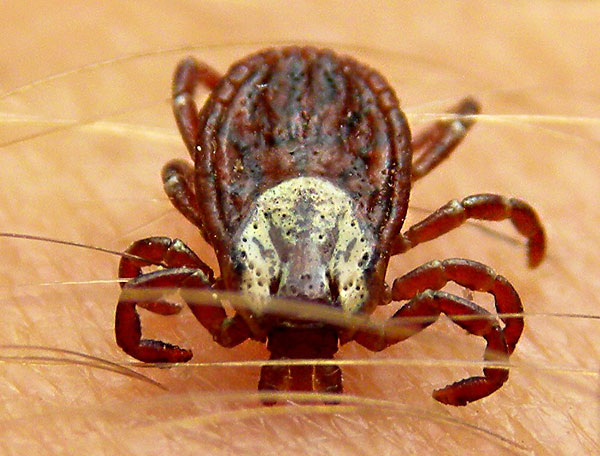
The tick immerses its proboscis along with its head under the skin, injecting an anesthetic, so a person may not notice for a long time that there is a parasite on it.
The mouth apparatus of the tick is completely immersed in the wound and, due to its special structure, acts as an anchor, providing a strong anchorage in the skin. The feeding process can last from several hours to a week until the tick is completely satiated.
Precautions in nature
When going on a forest walk (including a pine forest), you need to remember the following: precautions:
- Close the body as much as possible. The collar and cuffs should fit snugly around the neck and arms, the jacket should be tucked into the pants, and the pants into the socks, then the tick will not be able to get under the clothes;
- Do not forget about the headdress, choose clothes in light colors - it will be easier to see the parasite on it;
- If possible, try to avoid the favorite habitats of these arachnids. These are animal trails, pastures, clearings with shrubs and tall grass. Do not lie down on the forest floor;
- Every 10-15 minutes inspect clothes, and at a halt - the whole body;
- Use tick bite protection. Depending on the composition, they can scare away bloodsuckers or kill ticks that have fallen on the treated surface. Repellents should be applied, according to the instructions, either on the skin, or on clothing and skin, or only on clothing.To protect children, you should use special repellents that are safe for use in childhood.
These rules should always be remembered when going to nature, and it doesn’t matter if it is a pine or deciduous forest - ticks can lie in wait everywhere.
Informative video about ticks and diseases carried by these parasites


